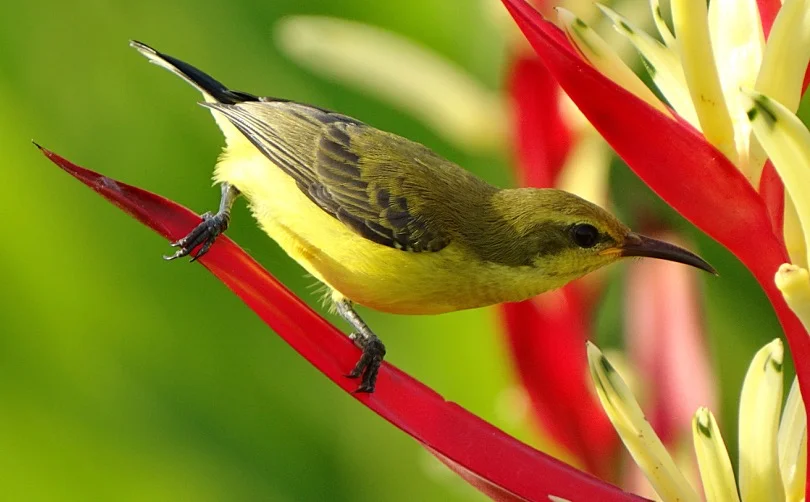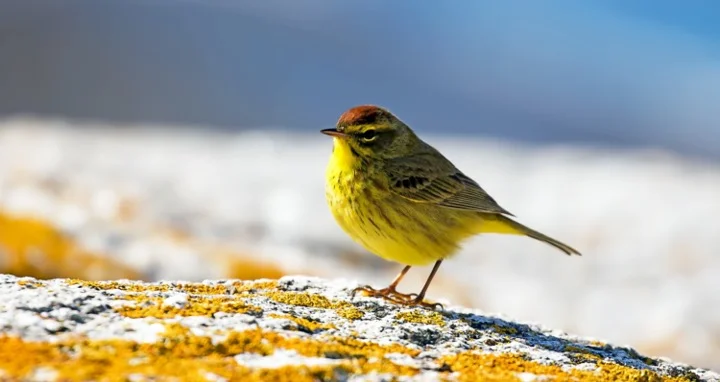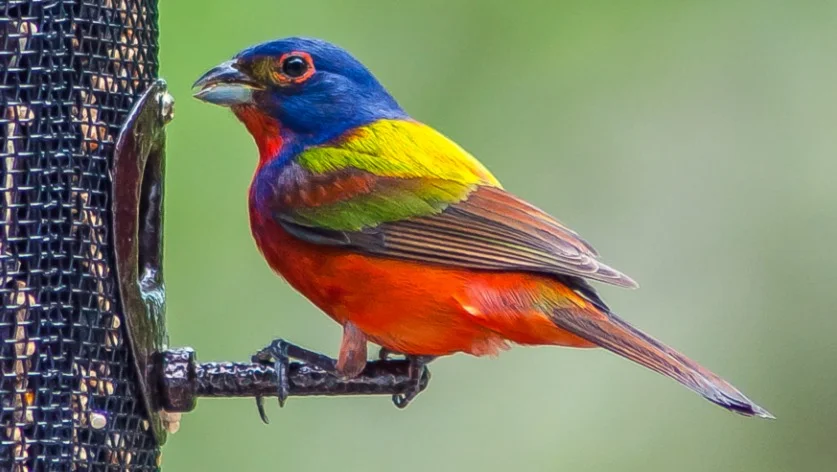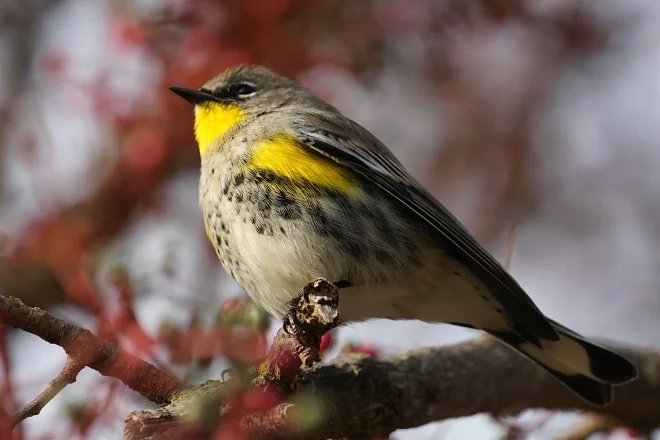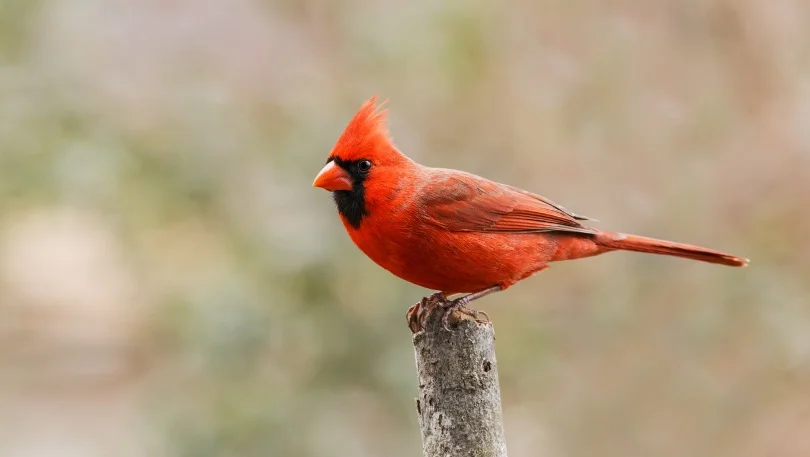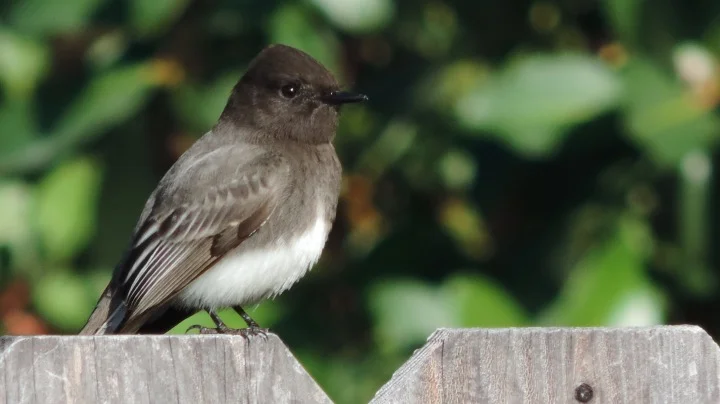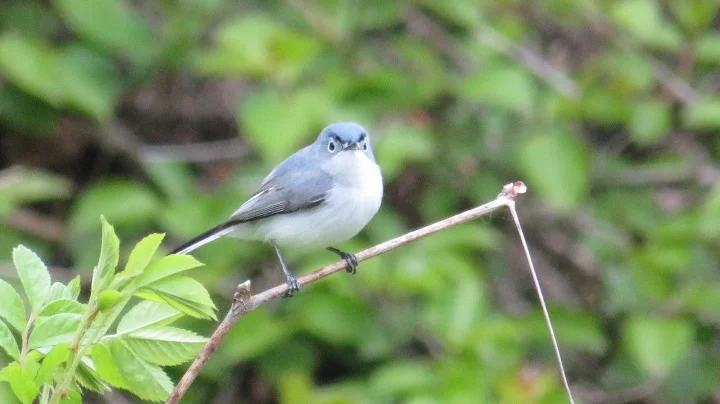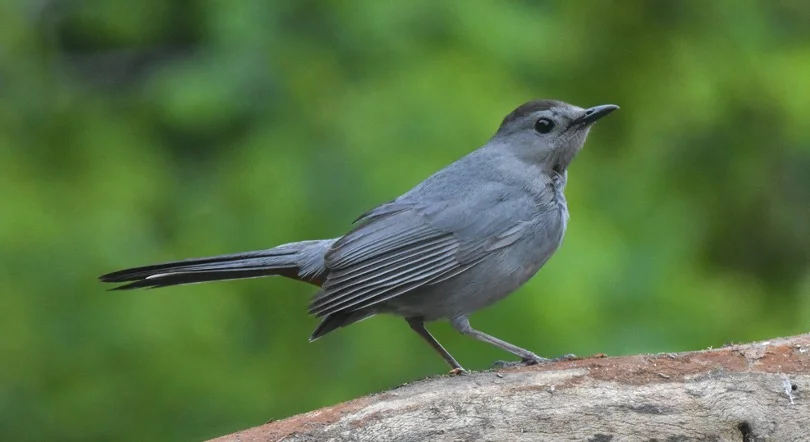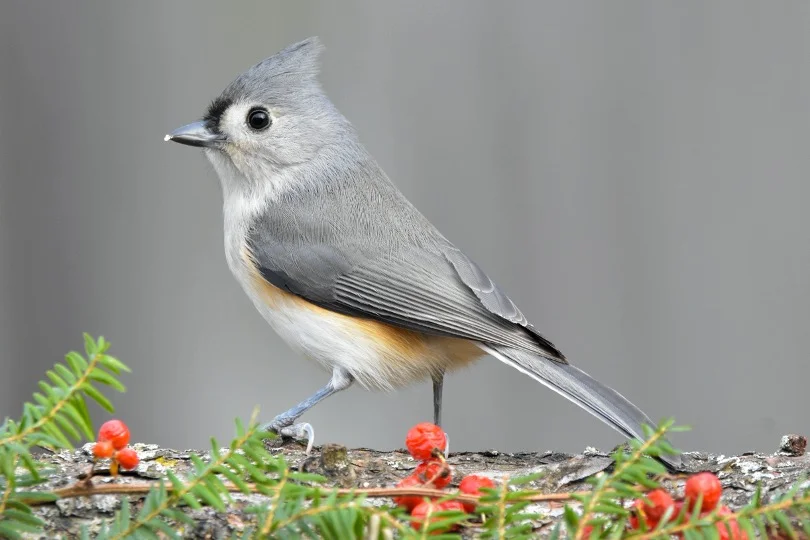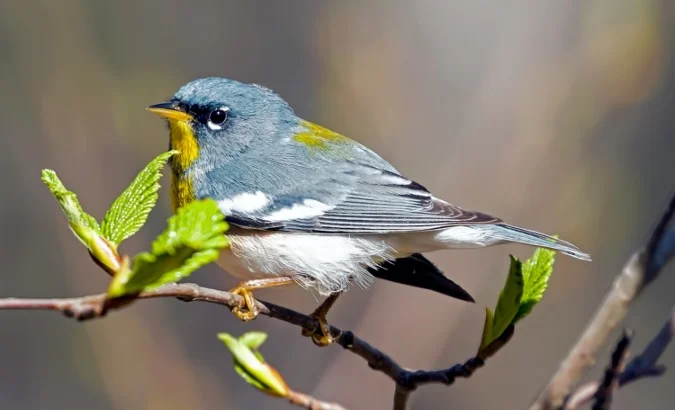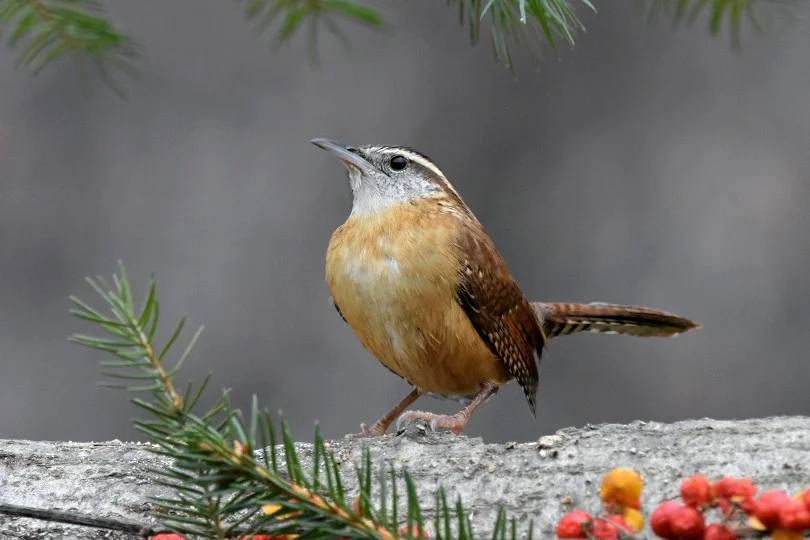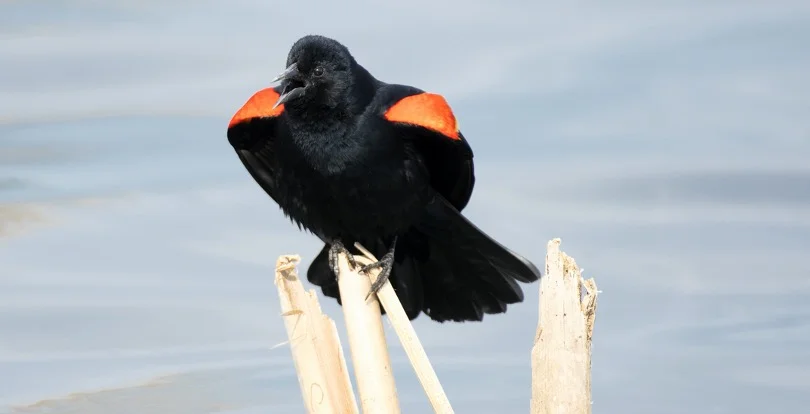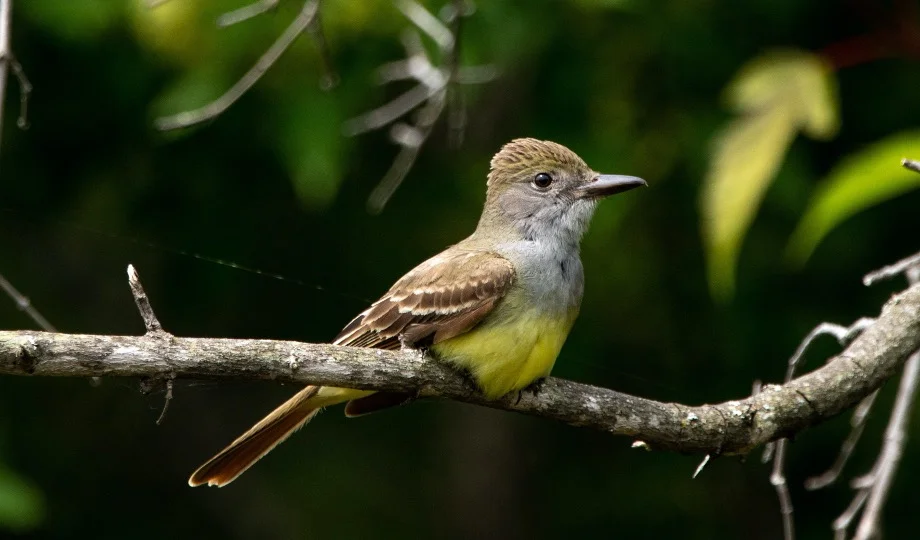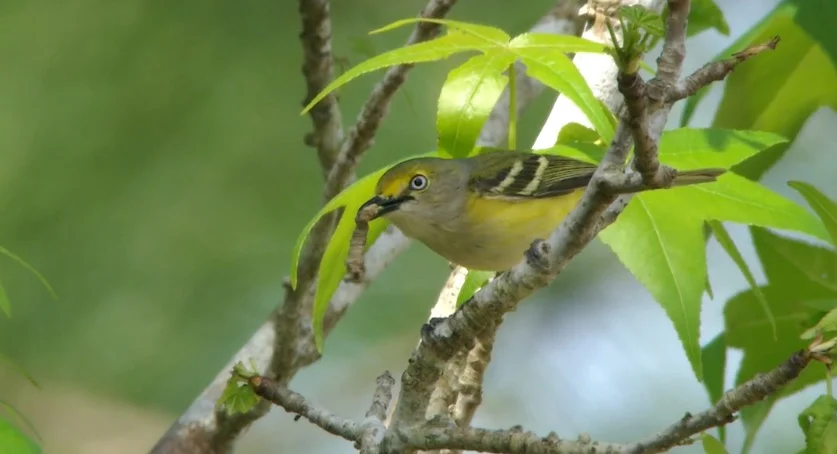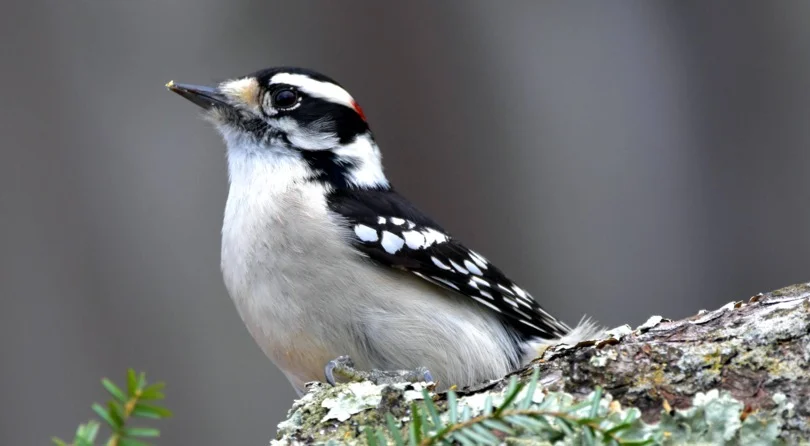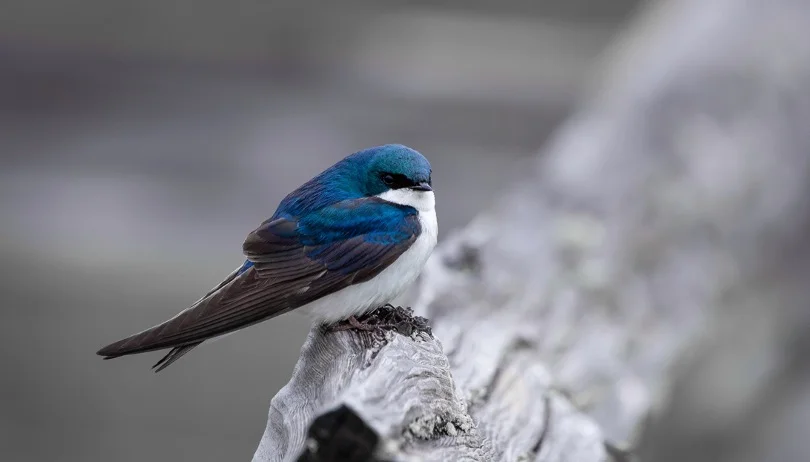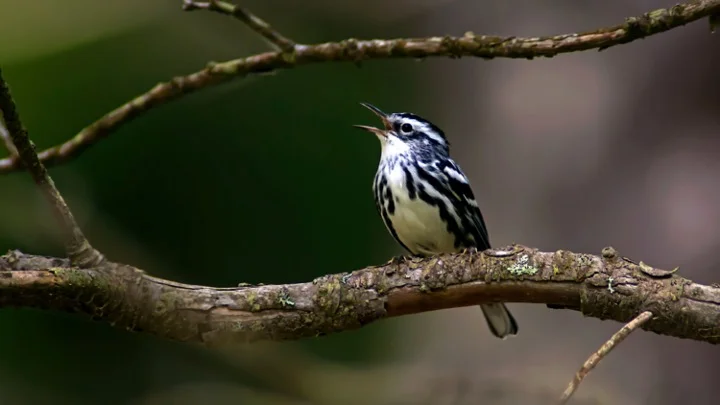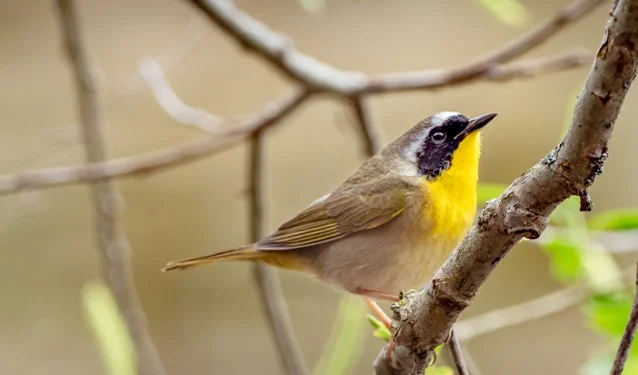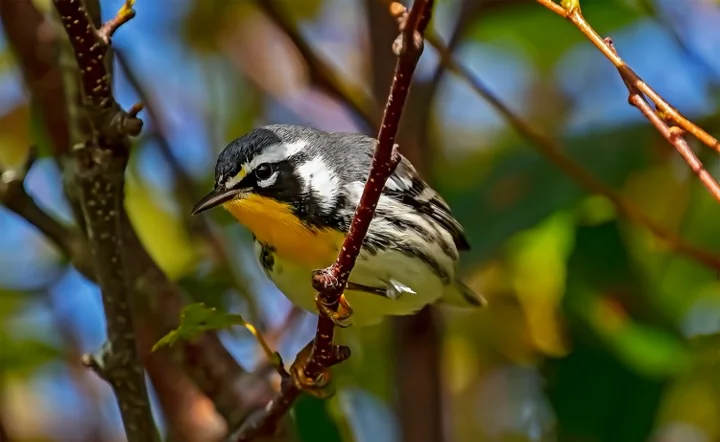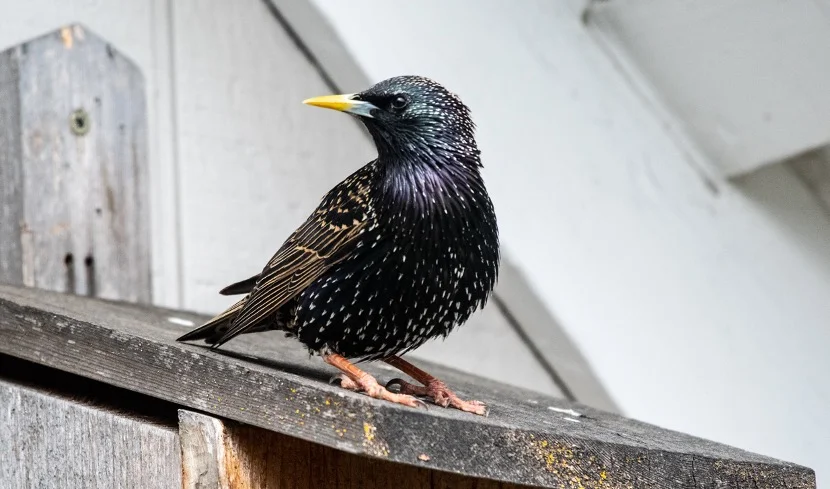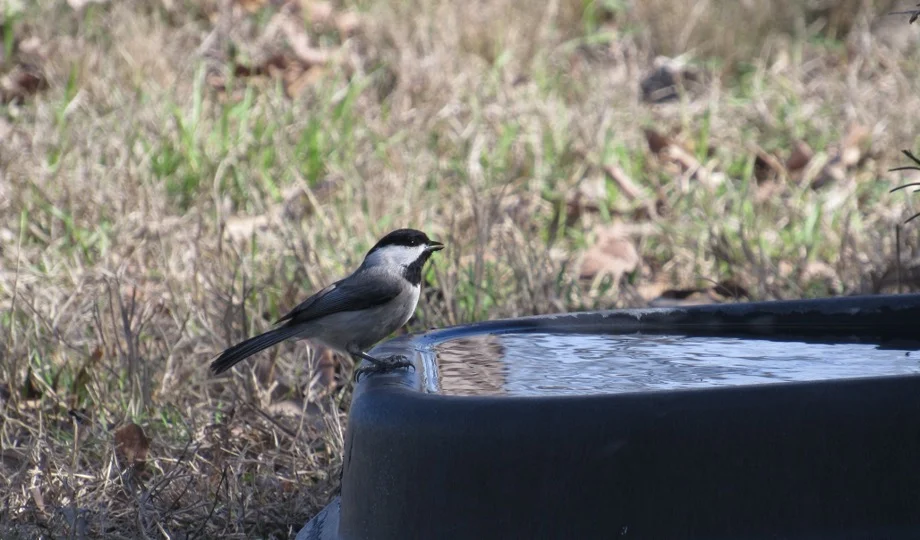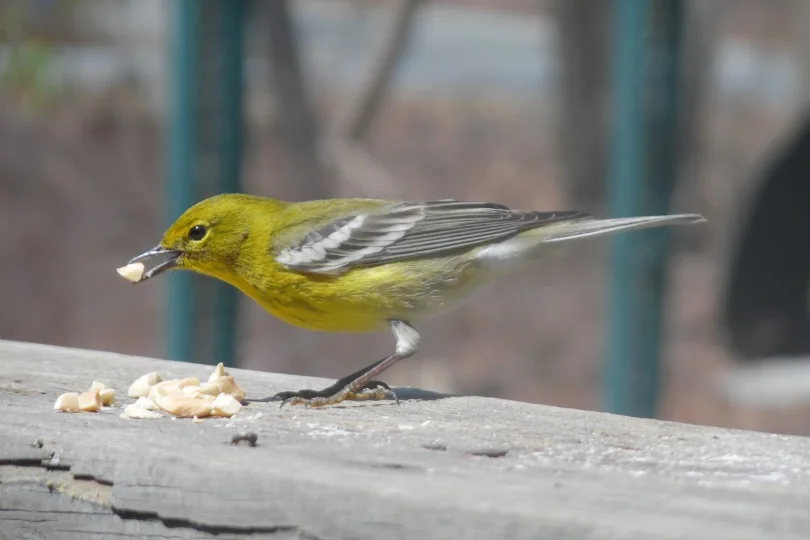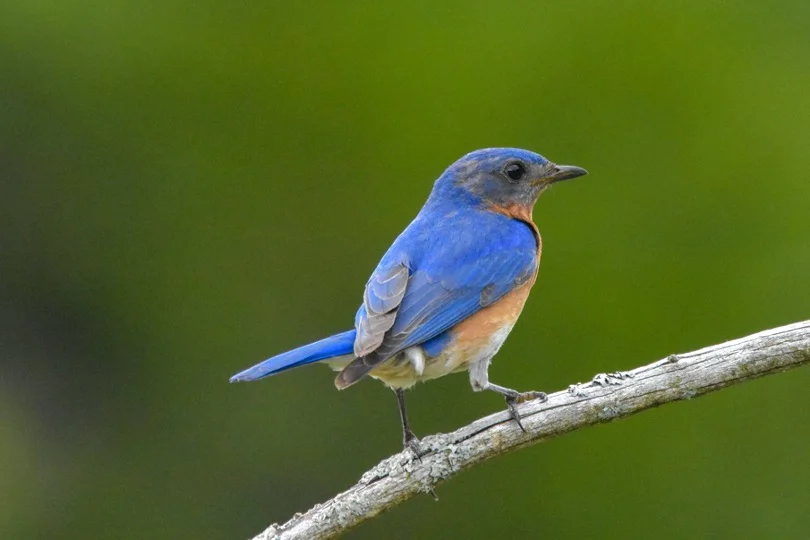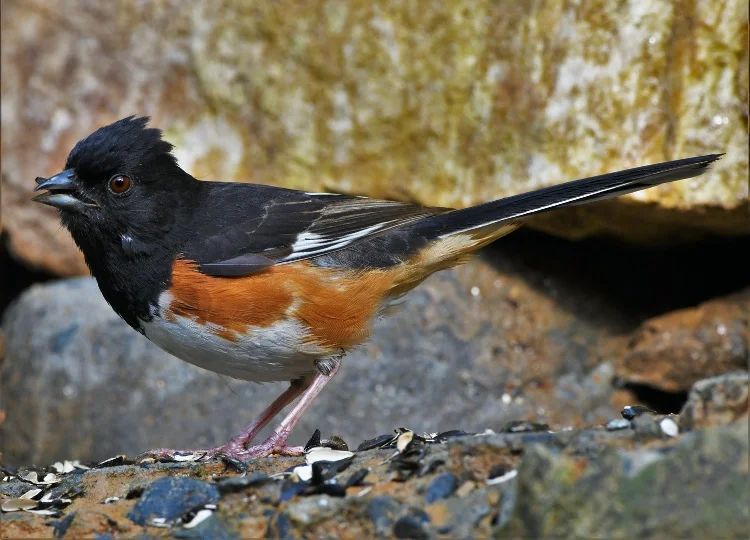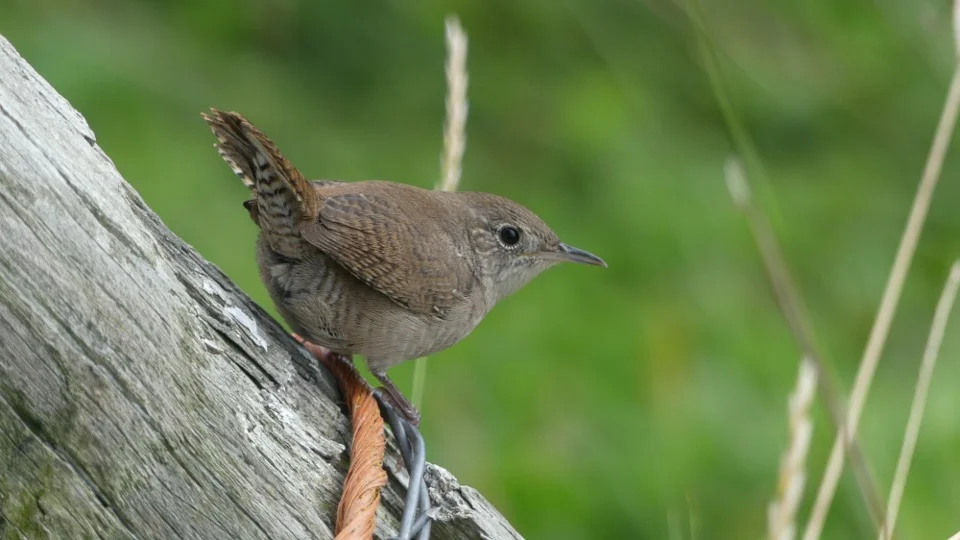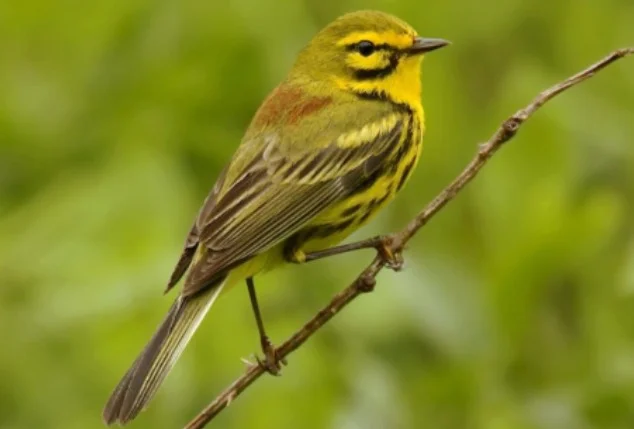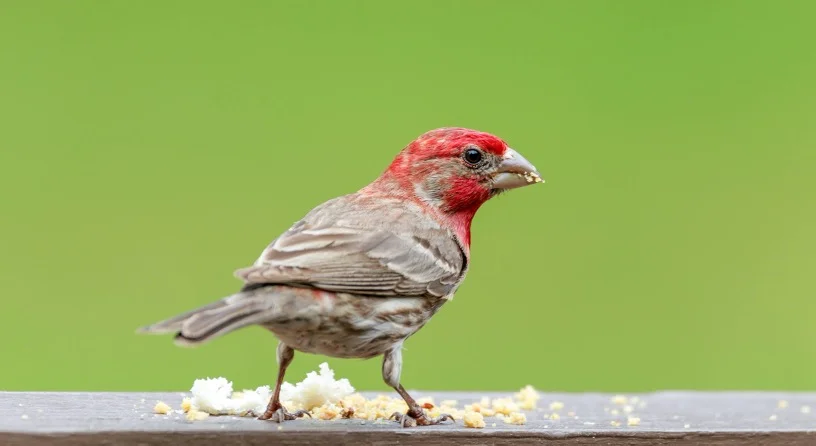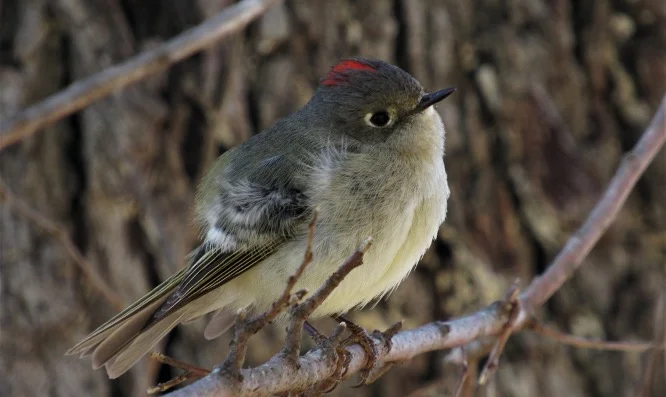27 Small Birds In Florida: Identification With Pictures & Songs
Beautiful little birds are one of nature’s most intriguing and vibrant species. A link to nature and fun can be found in watching the various types of backyard birds, which can be a source of enjoyment for many people.
Florida has many small-sized bird species, therefore it may not be as simple as it first appears to identify small backyard birds there. In this article, we’ll go over the most prevalent little birds of Florida to assist you in recognizing the bird you observed with images and their sounds.
27 Small Birds in Florida
-
Palm Warbler (Setophaga palmarum)
-
Painted Bunting (Passerina ciris)
-
Yellow-rumped Warbler (Setophaga coronata)
-
Northern Cardinal (Cardinalis cardinalis)
-
Eastern Phoebe (Sayornis phoebe)
-
Blue-gray Gnatcatcher (Polioptila caerulea)
-
Gray Catbird (Dumetella carolinensis)
-
Tufted Titmouse (Baeolophus bicolor)
-
Northern Parula (Setophaga americana)
-
Carolina Wren (Thryothorus ludovicianus)
-
Red-winged Blackbird (Agelaius phoeniceus)
-
Great Crested Flycatcher (Myiarchus crinitus)
-
White-eyed Vireo (Vireo griseus)
-
Downy Woodpecker (Picoides pubescens)
-
Tree Swallow (Tachycineta bicolor)
-
Black-and-white Warbler (Mniotilta varia)
-
Common Yellowthroat (Geothlypis trichas)
-
Yellow-throated Warbler (Setophaga dominica)
-
European Starling (Sturnus vulgaris)
-
Carolina Chickadee (Poecile carolinensis)
-
Pine Warbler (Setophaga pinus)
-
Eastern Bluebird (Sialia sialis)
-
Eastern Towhee (Pipilo erythrophthalmus)
-
House Wren (Troglodytes aedon)
-
Prairie Warbler (Setophaga discolor)
-
House Finch (Haemorhous mexicanus)
-
Ruby-crowned Kinglet (Regulus calendula)
1. Palm Warbler
- Scientific name: Setophaga palmarum
- Length: 4.7-5.5 in (12-14 cm)
- Weight: 0.3-0.5 oz (7-13 g)
- Wingspan: 7.9-8.3 in (20-21 cm)
Palm Warblers have a characteristic reddish head and spend the most of their time swinging their tails on the ground. This makes them more visible than most warblers that live up in the trees.
Don’t be fooled by the name; they are not found on palm trees. The palm warbler has a rusty red patch on the top of the skull and is browny-olive the rest of the time. Although they breed in Canada, they can be located in the eastern states throughout migration and all year in the extreme south coast and in Florida.
Listen Palm Warbler Song
Citation: Christopher McPherson, XC691646. Accessible at www.xeno-canto.org/691646.
It measures 7.9 to 8.3 inches in wingspan, 4.7 to 5.5 inches in length, and weighs 7 to 13 grams. Palm Warblers are mostly found in Canada, however they can be observed in the eastern United States during migration.
Some spend the winter in Florida and along the southeast coast. It’s best to look for them in weedy fields, woodland borders, and scrubby places in the spring and fall. They are frequently seen hunting for insects along the ground alongside other birds such as Sparrows, Juncos, and Yellow-rumped Warblers.
Plant native plants that attract insects, as well as bayberry or hawthorn for their berries, to lure more Palm Warblers to your garden.
2. Painted Bunting
- Scientific name: Passerina ciris
- Length: 4.7-5.1 in (12-13 cm)
- Weight: 0.5-0.7 oz (13-19 g)
- Wingspan: 8.3–9.1 in (21–23 cm)
Male Painted Buntings have brilliant blue heads, green wings, and backs, as well as a colorful patchwork of primarily red underbelly. Females Painted Buntings are a vivid yellow-green color.
The south-central and certain coastal regions of the southeastern states are where the Painted Bunting breeds in a select few US states. It measures 4.7 to 5.1 inches in length and weighs 13 to 19 grams.
Listen Painted Bunting Song
Citation: Russ Wigh, XC564624. Accessible at www.xeno-canto.org/564624.
During the breeding season, the Painted Bunting mostly forages for seeds and insects in semi-open areas. The female of the Painted Bunting builds the nests, which are concealed in foliage approximately five feet from the ground, consisting of twigs, bark, grass, and other plant materials.
They line them with horsehair and hold it all together with cobwebs. They deposit four eggs, which take around ten days to hatch before the young hatch after another nine days.
3. Yellow-rumped Warbler
- Scientific name: Setophaga coronata
- Length: 4.7-5.5 in (12-14 cm)
- Weight: 0.4-0.5 oz (12-13 g)
- Wingspan: 7.5-9.1 in (19-23 cm)
Yellow-rumped Warblers have a grey body with yellow flashes on the face, flanks, and rump, as well as white wings. Females are somewhat browner than males, and winter birds are lighter brown with brilliant yellow rumps and flanks, which become bright yellow and grey in spring.
Listen Yellow-rumped Warbler Song
Citation: Sunny Tseng, XC753694. Accessible at www.xeno-canto.org/753694
They move in vast numbers south after breeding mostly in Canada, over most of the southern and central states, the Pacific Coast, and into Mexico and Central America. It measures 7.5 to 9.1 inches in wingspan, 4.7 to 5.5 inches in length, and weighs 12 to 13 grams.
Yellow-rumped Warblers can be found in coniferous woods, particularly during the nesting season, and in open regions with fruiting shrubs during the winter.
During the summer, they consume largely insects and migrate, but during the winter, they eat mostly fruit, such as bayberry and wax myrtle. Sunflower seeds, suet, raisins, and peanut butter can all be used to lure Yellow-rumped Warblers to our garden.
4. Northern Cardinal
- Scientific name: Cardinalis cardinalis
- Length: 8.3-9.1 in (21-23 cm)
- Weight: 1.5-1.7 oz (42-48 g)
- Wingspan: 9.8-12.2 in (25-31 cm)
The brilliant red male Northern Cardinal featuring black surrounding his face is a stunning sight, especially against a snowy winter background. With their brown coloration, pointed brown crest, red accents, and red beaks, the females are likewise a bit spectacular.
Listen Northern Cardinal Song
Citation: Pat Goltz, XC470302. Accessible at www.xeno-canto.org/470302.
It has a wingspan of 9.8 to 12.2inches, a length of 8.3 to 9.1inches, and weighs between 42 and 48 grams. During mating season, Northern Cardinals will occasionally fight their own reflection in order to protect their territories.
Sunflower seeds, peanut hearts, millet, and milo may all be used to entice more Northern Cardinals to garden feeders. They will consume food from huge tube feeders, hoppers, platform feeders, or food that has been dispersed on the ground.
5. Eastern Phoebe
- Scientific name: Sayornis phoebe
- Length: 5.5-6.7 in (14-17 cm)
- Weight: 0.6-0.7 oz (16-21 g)
- Wingspan: 10.2-11.0 in (26-28 cm)
Eastern Phoebes are chubby songbirds with grayish-brown backs, pale underparts, and a darker head. They are migratory birds that breed in the northeastern and central United States, as well as in Canada, before travelling to the southeast and Mexico for the winter.
Some birds may spend the entire year in the south of their range. It has a wing spread of 10.2 to 11 inches, a length of 5.5 to 6.7 inches, and weighs between 16 and 21 grams.
Listen Eastern Phoebe Song
Citation: Chase M, XC566104. Accessible at www.xeno-canto.org/566104.
Eastern Phoebes are often encountered alone, rather than in couples or flocks, waving their tails from low perches in peaceful woods. Flying insects account for the majority of their food because they are flycatchers, although they will also consume spiders and other insects, as well as tiny berries and seeds.
They frequently build mud and grass nests on bridges, barns, and homes. Install a nest box or natural plants that yield berries to attract additional Eastern Phoebes to our garden.
6. Blue-gray Gnatcatcher
- Scientific name: Polioptila caerulea
- Length: 3.9-4.3 in (10-11 cm)
- Weight: 0.2-0.3 oz (4.8-8.9 g)
- Wingspan: 6.3 in (16 cm)
A little songbird with a delicate blue-gray back and a grayish-white underside. They also have black tail as well as black spots on their wings. In the summer, males have a prominent black ‘V’ shape on their brows.
They feature lengthy tails and legs, as well as short, straight bills. It has a wingspan of 6.3 inches, a body length of 3.9 to 4.3 inches, and weighs between 4.8 and 8.9 grams.
Listen Blue-gray Gnatcatcher Song
Citation: Scott Crabtree, XC764152. Accessible at www.xeno-canto.org/764152.
They nest in deciduous forests in the southern and eastern states and spend the entire year in Florida and along the southern coast.
Blue-gray Gnatcatcher nests resemble hummingbird nests in that they are tiny and erected onto branches, resembling a tree knot coated with lichen. Feeding off insects and spiders by skipping around and frightening them with their tail flicking up and down.
7. Gray Catbird
- Scientific name: Dumetella carolinensis
- Length: 8.3-9.4 in (21-24 cm)
- Weight: 0.8-2.0 oz (23.2-56.5 g)
- Wingspan: 8.7-11.8 in (22-30 cm)
Gray Catbirds get their name from its characteristic catty mew sound, which may last up to ten minutes. They include medium-sized songbirds with slate grey plumage, a black crown and tail, and a scarlet spot underneath their tails.
It has a wing span of 8.7 to 11.8 inches, a length of 8.3 to 9.4 inches, and weighs between 23.2 and 56.5 grams.
Listen Gray Catbird Song
Citation: Meena Haribal, XC425802. Accessible at www.xeno-canto.org/425802.
Gray Catbirds breed in much of the United States, with the exception of the Pacific Coast, and inland along the west and southwest before migrating south to the Gulf Coast of the United States, Mexico and Central America, as well as the West Indies.
Some remain near the Atlantic Coast throughout the year. Gray Catbirds can be found in thick bushes, tiny trees, and along forest borders or hedgerows.
Fruit and fruit trees or shrubs including dogwood, winterberry, as well as serviceberry might entice more Gray Catbirds to their garden feeders.
8. Tufted Titmouse
- Scientific name: Baeolophus bicolor
- Length: 5.5-6.3 in (14-16 cm)
- Weight: 0.6-0.9 oz (18-26 g)
- Wingspan: 7.9-10.2 in (20-26 cm)
The Tufted Titmouse is grey on the back and white on the underside, with a lovely grey crest and wide eyes, and it frequently congregates with chickadees, nuthatches, and woodpeckers.
Listen Tufted Titmouse Song
Citation: Brian, XC376462. Accessible at www.xeno-canto.org/376462.
It has a wingspan of 7.9 to 10.2 inches, a body length of 5.5 to 6.3 inches, and weighs between 18 and 26 grams. They live in the eastern and southeastern states. They are seen in forests, parks, and on home feeders, and may be aggressive with smaller birds.
Tufted Titmice can be attracted to their garden feeders by using sunflower seeds, suet, and peanuts in tube feeders or suet cages. They will also consume food from platform feeders.
Find All The Interesting Facts About Bird Watching!
9. Northern Parula
- Scientific name: Setophaga americana
- Length: 4.3-4.7 in (11-12 cm)
- Weight: 0.2-0.4 oz (5-11 g)
- Wingspan: 6.3-7.1 in (16-18 cm)
The Northern Parula is a cheerful warbler found in forests, with a vibrant contrast of grey and yellow. They have two white wingbars and are bluish-gray on the back with a yellow patch.
A chestnut ring distinguishes the males’ yellow neck and chest from the females’ yellow throat and chest. Females have a lighter complexion than men. It measures 6.3 to 7.1 inches in wingspan, 4.3 to 4.7 inches in length, and weighs 5 to 11 grams.
Listen Northern Parula Song
Citation: Thomas G. Graves, XC728355. Accessible at www.xeno-canto.org/728355.
Northern Parulas breed in the eastern United States and southeastern Canada before wintering in Central America and the Caribbean. They could stay in southern Florida for the winter.
High up in deciduous forests, they feed on insects and make nests in long clusters of lichen and moss that dangle from the trees. In the summer, gazing up at enormous clusters of hanging moss is the easiest method to spot them.
10. Carolina Wren
- Scientific name: Thryothorus ludovicianus
- Length: 4.7-5.5 in (12-14 cm)
- Weight: 0.6-0.8 oz (18-22 g)
- Wingspan: 11.4 in (29 cm)
Carolina Wrens are timid birds with dark brown tops and light brown bottoms. They have a white brow stripe, a tall tail, and a booming teakettle song.
It has a wingspan of 11.4 inches, a body length of 4.7 to 5.5 inches, and weighs between 18 and 22 grams. Carolina Wrens are year-round inhabitants in the eastern and southeastern United States.
Listen Carolina Wren Song
Citation: Daniel Parker, XC481961. Accessible at www.xeno-canto.org/481961.
They may be found in densely forested places or in the woods, and they will visit garden feeders. Suet feeders, hulled sunflower seeds, or peanut hearts in big tube feeders or on platform feeders can entice more Carolina Wrens to their garden feeders.
11. Red-winged Blackbird
- Scientific name: Agelaius phoeniceus
- Length: 6.7-9.1 in (17-23 cm)
- Weight: 1.1-2.7 oz (32-77 g)
- Wingspan: 12.2-15.8 in (31-40 cm)
Red-winged blackbirds are quite frequent and simple to distinguish because to their all-black appearance and brilliant red and yellow shoulder patches. In compared to the brown streaky coloration of the males, the females are quite drab.
It has a wingspan of 12.2 to 15.8 inches, a body length of 6.7 to 9.1 inches, and weighs 32 to 77 grams. Red-winged Blackbirds may be found in most states as well as Mexico and Central America.
Listen Red-winged Blackbird Song
Citation: Scott Olmstead, XC729039. Accessible at www.xeno-canto.org/729039.
For the winter, some travel short distances south from Canada. They are frequently seen perched on telephone lines, and during the mating season, the males might fiercely protect their territory, even attacking individuals who come too close to nests.
During the winter, they roost by the millions. Spread mixed grain and seeds on the ground to entice numerous Red-winged blackbirds to their garden. They will eat from huge tube feeders or platform feeders as well.
12. Great Crested Flycatcher
- Scientific name: Myiarchus crinitus
- Length: 6.7-8.3 in (17-21 cm)
- Weight: 0.9-1.4 oz (27-40 g)
- Wingspan: 13.4 in (34 cm)
The back of a Great Crested Flycatcher is brown, with both a yellow belly and a grey neck. The wing and tail plumes exhibit crimson flashes. The crest is not visible. It has a wingspan of 13.4 inches, a body length of 6.7 to 8.3 inches, and weighs between 27 and 40 grams.
The Great Crested Flycatcher breeds in much of Eastern North America and spends the winter in southern Florida, southern Mexico, and Central America. They perch high in the woods, waiting for large flying insects such as butterflies, grasshoppers, moths, wasps, and spiders.
Listen Great Crested Flycatcher Song
Citation: Sue Riffe, XC578069. Accessible at www.xeno-canto.org/578069.
They can be found in mixed forests, clearings, parks, and tree-lined neighborhood, as well as perched on fenceposts and other man-made structures. They will eat berries and tiny fruit as well.
Planting native plants and leaving brush piles to attract insects will help you attract more Great Crested Flycatchers to your property. Plant berry-producing plants and erect a nest box since they will quickly live permanently in them.
13. White-eyed Vireo
- Scientific name: Vireo griseus
- Length: 4.3-5.1 in (11-13 cm)
- Weight: 0.3-0.5 oz (10-14 g)
- Wingspan: 6.7 in (17 cm)
A tiny songbird with grey and yellow colouring. White-eyed Vireos have a grey head, a white breast and neck, yellow sides, darker wings, and two white wingbars with black streaks.
Listen White-eyed Vireo Song
Citation Bruce Lagerquist, XC714441. Accessible at www.xeno-canto.org/714441.
They have yellow around their eyes and on their forehead, as well as a white eye. It has a 6.7-inch wingspan, a length of 4.3 to 5.1 inches, and a weight of 10 to 14 grams. Spending the summer hiding in thickets around the southeastern United States.
They spend the winter along the southeastern coast, in Mexico, and in the Caribbean. Insects, flies, and spiders located in overgrown pastures and brambles are eaten by White-eyed Vireos.
14. Downy Woodpecker
- Scientific name: Picoides pubescens
- Length: 5.5-6.7 in (14-17 cm)
- Weight: 0.7-1.0 oz (21-28 g)
- Wingspan: 9.8-11.8 in (25-30 cm)
Downy Woodpeckers are tiny birds that use feeders in backyards. They are frequently mistaken for other birds including chickadees and nuthatches. They are all black and white with a red spot on the back of their heads.
Listen Downy Woodpecker Song
Citation: Paul Driver, XC772366. Accessible at www.xeno-canto.org/772366.
They resemble the Hairy Woodpecker. It has a wingspan of 9.8 to 11.8 inches, a body length of 5.5 to 6.7 inches, and weighs between 21 and 28 grams. Most US states and Canada are home to Downy Woodpeckers.
Suet feeders will attract more Downy Woodpeckers to your garden, but they’ll also devour black oil sunflower seeds, millet, and peanuts from platform feeders.
15. Tree Swallow
- Scientific name: Tachycineta bicolor
- Length: 4.7-5.9 in (12-15 cm)
- Weight: 0.6-0.9 oz (16-25 g)
- Wingspan: 11.8-13.8 in (30-35 cm)
Tree Swallows are little birds with blue-green backs and white underwings, with darker grey wings in males. Females have a darker skin tone.
It has a wing spread of 11.8 to 13.8 inches, a length of 4.7 to 5.9 inches, and weighs between 16 and 25 grams. Breeding over most of the United States, Canada, and Alaska before moving to the Gulf Coast, Florida, Mexico, and the southern border.
Listen Tree Swallow Song
Citation Christopher McPherson, XC600068. Accessible at www.xeno-canto.org/600068.
They may be spotted during migration over southern states, when they can form massive flocks numbering in the hundreds of thousands.
Tree Swallows may be found in forested swamps, fields, marshes, and near water, where they feed on flying insects. Nest boxes are a way of attracting numerous Tree Swallows to their garden.
16. Black-and-White Warbler
- Scientific name: Mniotilta varia
- Length: 4.3-5.1 in (11-13 cm)
- Weight: 0.3-0.5 oz (8-15 g)
- Wingspan: 7.1-8.7 in (18-22 cm)
Because of their stiped look, black-and-white Warblers are more easily identified. Males have a bigger and darker black patch over the eye and cheek than females.
Listen Black-and-White Warbler Song
Citation Christopher McPherson, XC690968. Accessible at www.xeno-canto.org/690968.
It measures 7.1 to 8.7 inches in wingspan, 4.3 to 5.1 inches in length, and weighs 8 to 15 grams. Wintering grounds for black-and-white warblers include Florida, the Gulf Coast, Mexico, Baja California, the Caribbean, and South America.
In the spring, they migrate north over the southern United States and east to west along the border with Canada. They may be seen bouncing vertically and horizontally on tree stems and branches in search of insects.
17. Common Yellowthroat
- Scientific name: Geothlypis trichas
- Length: 4.3-5.1 in (11-13 cm)
- Weight: 0.3-0.3 oz (9-10 g)
- Wingspan: 5.9-7.5 in (15-19 cm)
Yellowthroats are little songbirds with long tails that are brownish on the back and bright yellow beneath. The males are wearing a black mask across their faces. The intensity of the yellow varies widely, and it may be more olive in areas beneath.
Listen Common Yellowthroat Song
Citation Thomas Magarian, XC531276. Accessible at www.xeno-canto.org/531276.
It has a wingspan of 5.9 to 7.5 inches, a length of 4.3 to 5.1 inches, and weighs 9 to 10 grams. Apart from Alaska and northern Canada, most of North America’s common yellowthroats spend the summer reproducing.
Some remain throughout the year near the Gulf Coast and the Pacific Southwest. In the spring and summer, they may be spotted in marshy or wetland locations, as well as brushy fields, where they live in dense, tangled vegetation. They mostly feed on insects and may be spotted in big backyards with lush foliage.
18. Yellow-throated Warbler
- Scientific name: Setophaga dominica
- Length: 5.1-5.5 in (13-14 cm)
- Weight: 0.3-0.4 oz (9-11 g)
- Wingspan: 8.3 in (21 cm)
The Yellow-throated Warbler, like the Common Yellowthroat, has a grey and white body with black stripes rather than a brown body. It has an 8.3-inch wingspan, a length of 5.1 to 5.5 inches, and weighs 9 to 11 grams.
Listen Yellow-throated Warbler Song
Citation Russ Wigh, XC570993. Accessible at www.xeno-canto.org/570993.
Yellow-throated Warblers breed in the southern United States and spend the winter in Florida, the Caribbean, and up the Gulf Coast into Central America. They spend most of their time in the tops of pine trees, however during migration they may graze lower down.
19. European Starling
- Scientific name: Sturnus vulgaris
- Length: 7.9-9.1 in (20-23 cm)
- Weight: 2.1-3.4 oz (60-96 g)
- Wingspan: 12.2-15.8 in (31-40 cm)
European starlings really aren’t native to Europe, yet they have become one of the most abundant songbirds. They are stocky black birds with purple, green, and blue iridescent tones.
It has a wingspan of 12.2 to 15.8 inches, a length of 7.9 to 9.1 inches, and may weigh up to 96 grams. Starlings mostly consume insects such as beetles, flies and caterpillars, earthworms, and spiders.
Listen European Starling Song
Citation: Beatrix Saadi-Varchmin, XC773181. Accessible at www.xeno-canto.org/773181.
Fruit such as cherries, holly berries, mulberries, Virginia Creeper, sumac, and blackberries, along with grains and seeds, are also consumed. They live throughout much of North America.
Some consider these birds to be a problem owing to their aggressive demeanour, and they may be observed sitting in groups on the tops of trees or soaring across fields in flocks. Black oil sunflower seeds, suet, cracked corn, as well as peanuts may all be used to entice additional European Starlings to their garden feeders.
20. Carolina Chickadee
- Scientific name: Poecile carolinensis
- Length: 3.9-4.7 in (10-12 cm)
- Weight: 0.3-0.4 oz (8-12 g)
- Wingspan: 5.9-7.9 in (15-20 cm)
Carolina Chickadees have huge heads, a black crown and neck, white cheeks and belly, and a velvety grey back, wings, and tail.
It measures 5.9 to 7.9 inches in wingspan, 3.9 to 4.7 inches in length, and weighs 8 to 12 grams. They resemble the Black-capped Chickadee in appearance, and they interbreed in which their ranges intersect.
Listen Carolina Chickadee Song
Citation Bruce Lagerquist, XC713263. Accessible at www.xeno-canto.org/713263.
They may be found in eastern and southeastern states in wooded regions, parks, and backyards. Black oil sunflower seeds, Nyjer seeds, suet feeders, or peanuts can all be used to attract additional Carolina Chickadees to your backyard feeders.
They will eat from most feeders, particularly tube feeders, suet cages, and platform feeders. They will also build their nests in nest boxes or nest tubes.
21. Pine Warbler
- Scientific name: Setophaga pinus
- Length: 5.1-5.5 in (13-14 cm)
- Weight: 0.3-0.5 oz (9-15 g)
- Wingspan: 7.5-9.1 in (19-23 cm)
Pine Warblers are little yellow birds with olive backs, white underbelly, and grey wingbars. Females may seem browner that have more whitish on their stomachs.
It has a wing spread of 7.5 to 9.1 inches, a length of 5.1 to 55 inches, and weighs between 9 and 15 grams. Pine Warblers, as the name implies, may be found in pine woods, frequently high up in the trees.
Listen Pine Warbler Song
Citation John Middleton, XC476138. Accessible at www.xeno-canto.org/476138.
They consume caterpillars, beetles, spiders, and other insects and larvae, as well as fruit and seeds when the weather is cooler. They live in the southeast United States, but those further north will travel south after breeding.
Tube feeders and platform feeders filled with millet, broken corn, sunflower seeds, peanut hearts, and suet will entice numerous Pine Warblers. Plant natural fruits and plants like bayberry, grape, sumac, and Virginia creeper as well.
22. Eastern Bluebird
- Scientific name: Sialia sialis
- Length: 6.3-8.3 in (16-21 cm)
- Weight: 1.0-1.1 oz (28-32 g)
- Wingspan: 9.8-12.6 in (25-32 cm)
Eastern Bluebirds are little thrushes with rounded heads, huge eyes, and plump bellies. The males have a deep blue back and a crimson underside. Females have a grayer upper body with blue in the wings and tail and a less vibrant orange-brown breast.
Listen Eastern Bluebird Song
Citation: Russ Wigh, XC570566. Accessible at www.xeno-canto.org/570566.
It has a wingspan of 9.8 to 12.6 inches, a body length of 6.3 to 8.3 inches, and weighs between 28 and 32 grams. They reside in meadows and could be seen perched on wires, poles, or low trees in search of insects.
They spend the most of their time in the eastern states, but they may move south for the winter to the far north. If your yard is quite wide and roomy, we can entice more Eastern Bluebirds by providing mealworms and nest boxes.
23. Eastern Towhee
- Scientific name: Pipilo erythrophthalmus
- Length: 6.8-8.2 in (17.3-20.8 cm)
- Weight: 1.1-1.8 oz (32-52 g)
- Wingspan: 7.9-11.0 in (20-28 cm)
Male Eastern Towhees are huge sparrows approximately the size of a Robin, with a black head, neck, and back, reddish flanks, long tails, and a white belly. Females are identical to males, but have brown hair instead of black. It has a wingspan of 7.9 to 11 inches, a body length of 6.8 to 8.2 inches, and a weight of 32 to 52 grams.
Listen Eastern Towhee Song
Citation: Christopher McPherson, XC444954. Accessible at www.xeno-canto.org/444954.
Resident throughout the southern states, however birds farther north migrate south for the winter and would only be seen on the western end of their range in the winter. Eastern Towhees can be found near the borders of woodlands and thickets, scavenging in the undergrowth.
If our backyard has overgrown borders, Eastern Towhees may visit feeders for falling seed. They will also approach platform feeders for black oil sunflower seeds, hulled sunflower seeds, cracked corn, and millet.
24. House Wren
- Scientific name: Troglodytes aedon
- Length: 4.3-5.1 in (11-13 cm)
- Weight: 0.3-0.4 oz (10-12 g)
- Wingspan: 5.9 in (15 cm)
House Wrens are little brown birds with darker barred wings and tails, as well as a lighter neck. Most states have breeding populations before travelling to the extreme south and Mexico for the winter.
It has a wingspan of 5.9 inches, a body length of 4.3 to 5.1 inches, and weighs between 10 and 12 grams. House Wrens can be seen hunting for insects and spiders such as beetles, caterpillars, and earwigs in brush heaps in backyards, parks, and open woodlands.
Listen House Wren Song
Citation Guillermo Treboux, XC552800. Accessible at www.xeno-canto.org/552800.
They are frequently seen jumping over tangles and low branches with their tails raised, stopping to sing their happy song. When it comes to acquiring the best nest holes, House Wrens are aggressive for their size, and they will often disturb larger birds, occasionally pulling eggs or nestlings out of a nest site they prefer.
You may entice more House Wrens to their backyard by leaving brush piles or erecting a nest box.
25. Prairie Warbler
- Scientific name: Setophaga discolor
- Length: 4.3 in (11 cm)
- Weight: 0.2-0.3 oz (6.4-8.8 g)
- Wingspan: 7 in (180 mm)
These little songbirds have an olive green back and a golden neck and belly. They have black streaks on the sides of their faces and a dark semicircle under their eyes. Female Prairie Warblers have a duller coloration.
Listen Prairie Warbler Song
Citation: Christopher McPherson, XC599841. Accessible at www.xeno-canto.org/599841.
It measures 4.3 inches long and weighs between 6.4 and 8.8 grams. They breed in the eastern and southeastern United States and spend the winter in Florida, the Caribbean, and certain Central American coastal locations.
Those that live in Florida all year are considered a distinct subspecies and are somewhat bigger. Despite their name, prairie warblers thrive in fields and woodlands.
26. House Finch
- Scientific name: Haemorhous mexicanus
- Length: 5.1-5.5 in (13-14 cm)
- Weight: 0.6-0.9 oz (16-27 g)
- Wingspan: 7.9-9.8 in (20-25 cm)
Male House Finches have a red head and breast, while females have brown streaks. Originally found only in the western states, it was brought to the eastern states and has thrived, even displacing the Purple Finch.
Listen House Finch Song
Citation Thomas Magarian, XC531574. Accessible at www.xeno-canto.org/531574.
It has a wingspan of 7.9 to 9.8 inches, a body length of 5.1 to 5.5 inches, and weighs between 16 and 27 grams. They are commonly seen in parks, farms, woodland borders, and backyard feeders.
They can be found in large, raucous groups that are difficult to overlook. Black oil sunflower seeds or nyjer seeds in tube feeders or platform feeders might entice more House Finches to garden feeders.
27. Ruby-crowned Kinglet
- Scientific name: Regulus calendula
- Length: 3.5-4.3 in (9-11 cm)
- Weight: 0.2-0.3 oz (5-10 g)
- Wingspan: 6.3-7.1 in (16-18 cm)
Ruby-crowned Kinglets are little olive-green songbirds with a vivid red crown that is normally flat and difficult to notice, but incredibly impressive if you do.
It has a wingspan of 6.3 to 7.1 inches, a body length of 3.5 to 4.3 inches, and weighs 5 to 10 grams. They breed in Canada and the western highlands before wintering in the southern and southwestern states and Mexico.
Listen Ruby-crowned Kinglet Song
Citation Jarrod Swackhamer, XC522476. Accessible at www.xeno-canto.org/522476.
They are also visible during migration when they are in large numbers. Ruby-crowned Kinglets are fast-moving, silent birds that dart around in the foliage of lower branches, bushes, and trees hunting for spiders and insects. They visit suet or platform feeders in search of hulled sunflower seeds, peanut hearts, and mealworms.
How To Identify Birds?
Here are some guidelines to allow you to determine birds so that you can document and locate the birds in a guide when you go out birding in Florida:
• Size: The most obvious feature of a bird is its size. In guidebooks, birds are frequently measured in inches or millimetres. It’s advisable to make a mental note of the bird’s size (little, medium, or giant) so you can find it later. A little bird is around the size of a sparrow, a medium bird is approximately the size of a pigeon, and a large bird is approximately the size of a goose.
• Shape: Take notice of the bird’s silhouette and jot it up or sketch the shape. Consider the length of the tail, the form of the bill, the shape of the wings, and the overall shape of the bird.
• Color Pattern: Make a note of the primary colour of the head, back, belly, wings, and tail, as well as any secondary colours or patterns. Take note of any patterns you notice, such as banding, spots, or highlights.
• Behavior: Unless they’re on the land or far up in the trees. Are they in groups or are they on their own? Can you figure out what they’re eating?
• Habitat: Woodlands, parks, bushes, grasslands or meadows, shores or marshes are all possible habitats.
